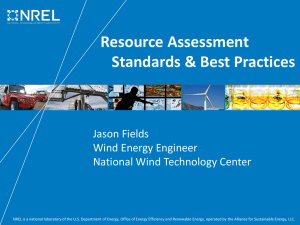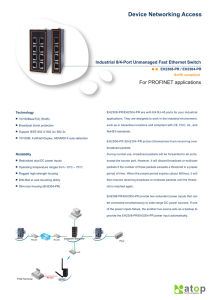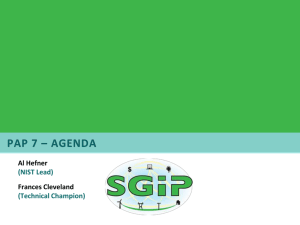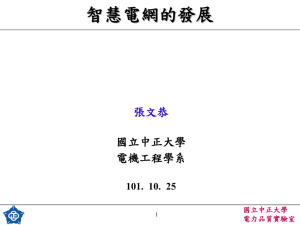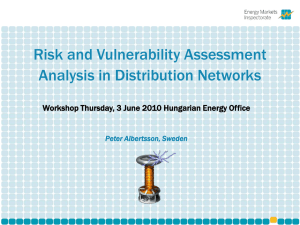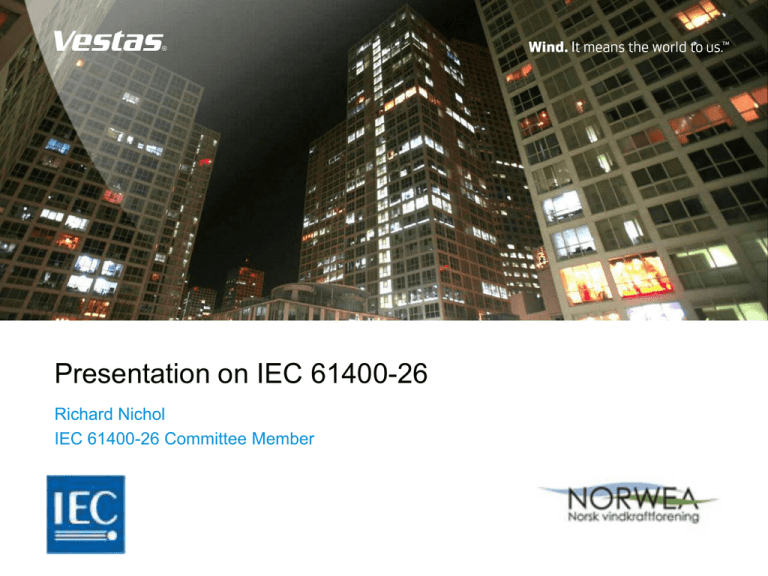
Presentation on IEC 61400-26
Richard Nichol
IEC 61400-26 Committee Member
Aim of this presentation
• Awareness of the IEC’s involvement in Standards in the Wind
Industry and why.
• Awareness of the IEC standard of ‘Availability’ & what stage it
is at.
• Awareness of the next stages of the Standard
• Where to go for more information.
The Need for Standards in the Wind Industry…
1970s – 1980s
3
Name of presentation
• Primarily; Owners &
Investors in US & Europe
approached the IEC with
a requirement to set
standards for
commericial WTGs.
• Main driver; Conformity
for Grid Regulation &
Financing
The Call to IEC on Availability…
Well
we…
Dear
Manufacturers
…What’s the
availability of
your WTGs…!!
Do it
this
way---
But we
do it this
way---
Therefore Owners & Investors
collectively made a request to IEC for
a standard so that they can better
manage their portfolio.
However
we do it
this way-Aaah..but
we do it
this way---
Example of some diferences…(no names…!)
• Some manufacturers do not count logistics time as Down Time….
ᅳ Therefore if it was a major fault and WTG was awaiting a part for 1 month WTG was
‘Available’
• Some manufacturers only count time during cut-in/cut-out….
ᅳ Therefore no indication of the turbine ‘state’ in no wind conditions..
• 1 Manufacturer did not include weekends and holidays…!
ᅳ So peoduction on weekends counted as upside sharing?!
• But most manufacturers have different nomenclatures/bins/names for events in
time and did not present all data or in a standard way…..
• Therefore Owners & Investors found it difficult to to ge a common picture..!
• Summary: IEC can help…Itcannot dictate this (as much of this is contractual
however) it can drive a common basis for calculating availability and be referenced
to in a contract.
What is the IEC?
IEC = International
Electrotechnical
Commission
• Founded in 1906
• world’s leading
organization for the
preparation and
publication of
International
Standards for all
electrical, electronic
and related
technologies.
IEC provides a platform
to companies,
industries and
governments for
meeting, discussing
and developing the
International Standards
they require
All IEC International
Standards are fully
consensus-based and
represent the needs of
key stakeholders of
every nation
participating in IEC
work. Every member
country, no matter how
large or small, has one
vote and a say in what
goes into an IEC
International Standard.
IEC TC 88 – Wind Turbines and it’s Role
A TC – Technical Committee prepares international standards for wind turbines that
convert wind energy into electrical energy.
These standards address design requirements, engineering integrity, measurement
techniques and test procedures. Their purpose is to provide a basis for design, quality
assurance and certification.
The standards are concerned with all subsystems of wind turbines, such as
mechanical and internal electrical systems, support structures and control and
protection systems. They are intended to be used together with appropriate IEC/ISO
standards.
• TC 88 creates sub committes (61400) for specific areas, examples are:
•
•
•
61400 – 12 (Power Curves)
61400-25 – Communications Protocols (open standard)
61400-26 - Availability for wind turbines and wind turbine plants
ᅳ 61400-26-1 – Time Based Availabiilty
ᅳ 61400-26-2 – Production based WTG Availability
ᅳ 61400-26-3 – Wind Power Plant Availability (Time & Production)
http://www.iec.ch/
But What is Time Based Availability? (Whiteboard time…?)
• 61400-26 - Availability for wind turbines
and wind turbine plants
ᅳ 61400-26-1 – Time Based Availabiilty
ᅳ 61400-26-2 – Production based WTG
Availability
ᅳ 61400-26-3 – Wind Power Plant Availability
(Time & Production)
61400-26-1 Time Based Availabiilty
• Convened 2008 with first element to focus on Time Based Availability (WTG)
• Chairman; Bob Sherwin (EAPC Wind Energy Services) , Secretary, Niels Raban
DONG Energy
• Quarterly Meetings, normally hosted by one of the committee members
• Typical attendees;
•
•
•
•
•
•
.
Manufacturers
ᅳ Vestas, GE, Gamesa, Enercon, Acciona, NORDEX, (Siemans)
Owners:
ᅳ EDPR, RWE, Iberdrola, Vattenfall, DONG, Statkraft, E.ON
Independents:
ᅳ Bachmann (Controllers), Garrad Hassan, Wind Specialists
26-1 Now awaiting final approval from TC 88 and likely publication after next TC 88 meeting
in September 2011
The committee is then broken down into National Commitees who represent their regions
and can vote against the standard (Denmark, US, Germany, Spain)
Two new nations recently joined, Russia (unknown) & South Africa (ESKOM – largest
producer of power in Africa).
Information categories
Mandatory
Mandatory
Level 2
Mandatory
Mandatory
Level 3
Level 4
Priority
FULL PERFORMANCE
(IAOGFP)
1
PARTIAL
PERFORMANCE
(IAOGPP)
2
TECHNICAL
STANDBY (IAONGTS)
3
OUT OF
ENVIRONMENTAL
SPECIFICATION
(IAONGEN)
4
REQUESTED
SHUTDOWN
(IAONGRS)
5
OUT OF ELECTRICAL
SPECIFICATION
(IAONGEL)
6
(IAONG)
NON-GENERATING
(IAO)
OPERATIVE
NON-OPERATIVE
(IANO)
(IA)
INFORMATION AVAILABLE
GENERATING
(IAOG)
Level 1
Mandatory
SCHEDULED MAINTENANCE
7
(IANOSM)
PLANNED CORRECTIVE ACTION (IANOPCA)
8
FORCED OUTAGE
9
(IANOFO)
SUSPENDED
10
(IANOS)
FORCE MAJEURE
(IAFM)
INFORMATION UNAVAILABLE
(IU)
11
12
Note..
Main document contains
definitions.
1-12 Priority (1 lowest)
An Additional non-mandatory
column can be added to give
more detail
Scenario:
1. Heavy Ice on Blades
(Running but not as maximum)
• Information Available
• Operative
• Generating
• Partial Performance
• (IAOGPP)
2. Wind Speed 1 m/s
• Operative
• Non-Generating
• Out of Environmental
Specification
• (IAONGEN)
Once categorised…
Key difference is multiple time states must be stored.
Example:
•
•
•
Dead unit all week due to gearbox….
AND
20 hrs of scheduled maintenance is done during the week
• Which one takes priority and what is the availability?
A unit if down all week due to
a gearbox failure. 20 h of
regular scheduled
maintenance is done during
this time
Down time is a higher priority
and you cannot enter
maintenance from this state
0,0 %
0,0 %
• This would affect Turbine Availability for assessing maintenance, but this priority
may differ on a Contract…
• The power of this IEC is that ‘hidden events’ are now visible, ie, the broken pump
issue may often be invisible to the customer in the data presented during a lighting
storm…….
A Picture Paints a Thousand Words…
WTG
Manufactuer
ACME installs
120mw in
Norway..
Severe
Lightening
Storms..
WTG forces
stop…
And the availability according to IEC 61400.26-1?
ACME Claim full
availability..
But 7/10 WTGs
had faulty oil
Pumps & could
not generate
Points to Remember on the IEC 61400-26-1
• It is a Techncial reference/specification, not a Standard.. But may become one do
in time (3 years?)
• -26-1 with TC 88 for final approval, once released will be copyrighted material.
•
•
•
•
•
•
It will help frame and drive contracts
It contains examples of formulaes for calculation
It contains full definitions for every state.
It does not specify the length of a time bin, ie, 10 minutes (possible technical inpact)
It states that you can store several states, which are then prioritised – this is new and could
have several perspectives!
It was a tough standard to agree on and now has created the foundation for Production
Based Availability
• 61400-26 - Availability for wind turbines and
wind turbine plants
ᅳ 61400-26-1 – Time Based Availabiilty
ᅳ 61400-26-2 – Production based WTG
Availability
ᅳ 61400-26-3 – Wind Power Plant Availability
(Time & Production)
IEC 61400-26-2 – WTG Production Based Availabilty
•
•
•
•
•
Same committee as 26-1 Standard
Last meeting held in Gotland, Sweden in May 2011
Framework for document produced
Next meeting September 2011 hosted by Vermont Wind
Expected timeline:
•
•
•
•
Sep 2011 –Vermont
Dec 2011– Hamburg (sponsored by Enercon)
March 2012 Tokyo (Sponsored by JWEA & Garrad Hassan
April 2012– Draft Submitted to TC 88 and National Committees for comment
• Jun 2012: Start Work on Wind Power Plant Availability…
• 61400-26 - Availability for wind turbines and
wind turbine plants
ᅳ 61400-26-1 – Time Based Availabiilty
ᅳ 61400-26-2 – Production based WTG
Availability
ᅳ 61400-26-3 – Wind Power Plant
Availability (Time & Production)
Thank you for your attention
Copyright Notice
The documents are created by Vestas Wind Systems A/S and contain copyrighted material, trademarks, and other proprietary information. All rights reserved. No part of the documents may be reproduced or copied in any form or by any
means—such as graphic, electronic, or mechanical, including photocopying, taping, or information storage and retrieval systems without the prior written permission of Vestas Wind Systems A/S. The use of these documents by you, or
anyone else authorized by you, is prohibited unless specifically permitted by Vestas Wind Systems A/S. You may not alter or remove any trademark, copyright or other notice from the documents. The documents are provided “as is” and
Vestas Wind Systems A/S shall not have any responsibility or liability whatsoever for the results of use of the documents by you. Vestas wishes to acknowledge and respect all copyrights in connection with the illustrations used in this
presentation. In case we have unintentionally violated copyrighted material, we want to be informed immediately in order to straighten things out and thus to honour any obligatory fees.


